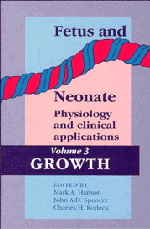Book contents
- Frontmatter
- Contents
- Preface to the series
- List of contributors
- Part I Physiology
- 1 Placental transfer
- 2 Nutrient requirements for normal fetal growth and metabolism
- 3 Hormonal control of fetal growth
- 4 Insulin-like growth factors and their binding proteins
- 5 Metabolism and growth during neonatal and postnatal development
- Part II Pathophysiology
- Part III Clinical applications
- Index
5 - Metabolism and growth during neonatal and postnatal development
from Part I - Physiology
Published online by Cambridge University Press: 04 August 2010
- Frontmatter
- Contents
- Preface to the series
- List of contributors
- Part I Physiology
- 1 Placental transfer
- 2 Nutrient requirements for normal fetal growth and metabolism
- 3 Hormonal control of fetal growth
- 4 Insulin-like growth factors and their binding proteins
- 5 Metabolism and growth during neonatal and postnatal development
- Part II Pathophysiology
- Part III Clinical applications
- Index
Summary
Introduction
The metabolic adaptations which occur between fetal and neonatal life represent a transition from a quiescent inactive state in which inhibitory stimuli dominate to one of near maximal rates of metabolic activity that are rarely matched during postnatal or adult life. These responses are necessary in order to establish breathing and maintain body temperature after birth, which are both important in determining not only survival but also an individual's ability to thrive. During late gestation, fetal energy demands are small (Power, 1989) and the conservation of energy by the fetus is a prerequisite for ensuring both growth and development (Jansen & Chernick, 1991). A major determinant of fetal development is the maternal metabolic and hormonal environment, which has a large influence on nutrient partitioning and therefore energy supply to the growing fetus (see Symonds & Lomax, 1992). The mother's influence on fetal growth and development is not confined to changes in nutrient supply, as the maternal environment also regulates fetal temperature both throughout the day (Gluckman et al., 1984) and during acute or chronic changes in metabolism (see Symonds et al., 1993).
Low rates of metabolic activity by the fetus are not only necessary to ensure growth but may contribute to periodic episodes of fetal breathing. This point is emphasized by the finding that cold stimulation of cutaneous thermoreceptors not only stimulates metabolism in conjunction with the onset of shivering activity but also results in continuous breathing (Johnston, Gunn & Gluckman, 1988).
- Type
- Chapter
- Information
- Fetus and Neonate: Physiology and Clinical Applications , pp. 117 - 136Publisher: Cambridge University PressPrint publication year: 1995



